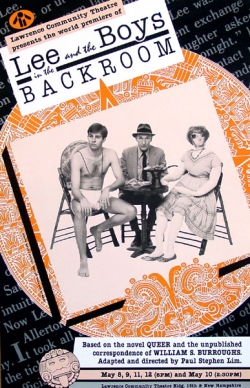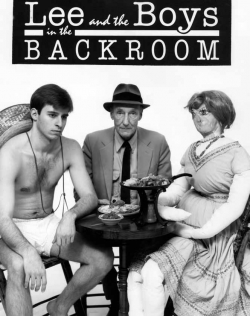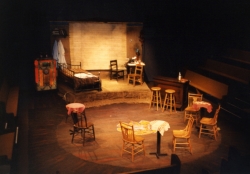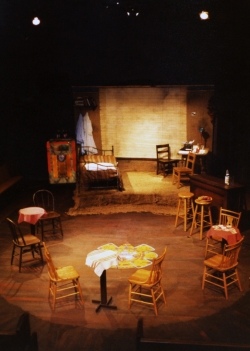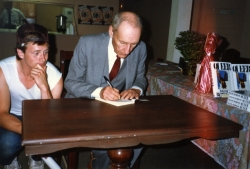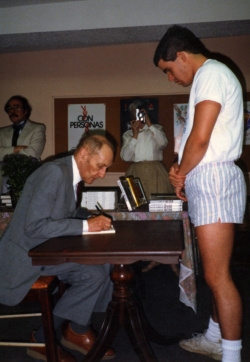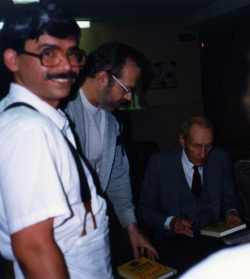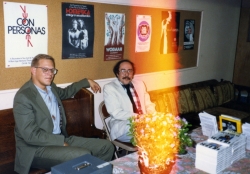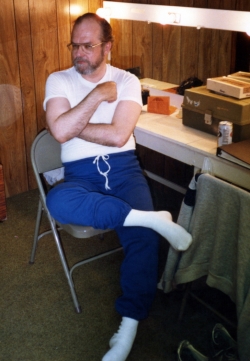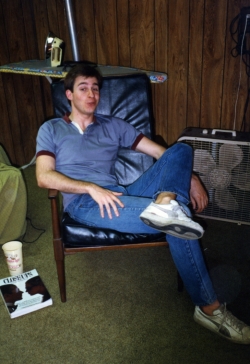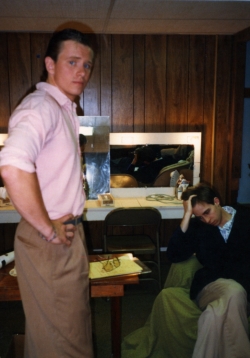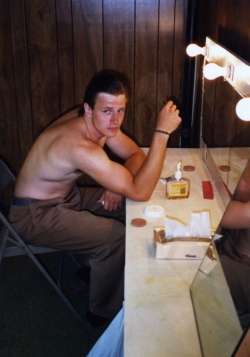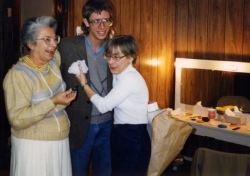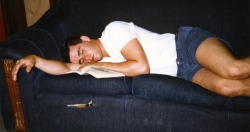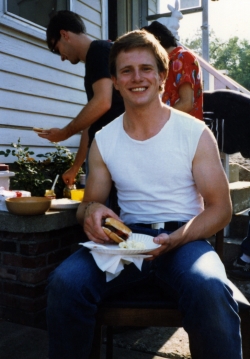Lee and the Boys in the Backroom: A Play Based on the Novel QUEER and the unpublished correspondence of WILLIAM S. BURROUGHS
Images from the Show
Overview
Requirements: 38 parts played by 8 M and 1F (Voice Only). Additionally, Lee’s wife Jane and Allerton’s girlfriend Mary will be represented on stage not by live actors but by life-sized ragdolls.
Setting: A bar, a bed-sitting room, a movie-house, and various streets in Mexico City, 1949-1952.
Plot: Lee and his wife Jane are American expatriates living on the fringe in Mexico City. Although Lee seems to have some affection for Jane, he is also unabashedly homosexual. He meets and falls desperately in love with Allerton, a young American who claims to be straight and who has a girlfriend named Mary. Lee wines and dines Allerton, and ultimately seduces him with outlandishly comic and absurdist stories which we see dramatized; and also with the promise of hallucigenic drugs and mushrooms. Because Jane and Mary are represented on stage by life-sized ragdolls with large eyes and pursed lips, they are aware at all times of what’s going on with these men in their lives, but they also remain essentially voice-less. When the sexual liaison doesn’t work and Allerton finally leaves, Lee is devastated. He sinks deep into an alcoholic abyss, and would not have recovered had there not been other friends around him who cared about his well-being.
Theme: This is a play about sexual passion and yearning; about what we do to our loved ones while we are pursuing other love interests, especially if the new objects of our affection are illusive and ultimately unattainable.
Notes: Because of my friendship with William S. Burroughs and James Grauerholz (see my NAKED LUNCH entries in the LIMERANCES section of this website), it was only a matter of time before someone would suggest that I adapt something by Burroughs for the stage. I forget now who made the initial suggestion. It might have been James Grauerholz himself, or it might have been Mary Doveton, the artistic director of the Lawrence Community Theatre, where my plays CHAMBERS and FLESH, FLASH AND FRANK HARRIS had originally premiered. I was intrigued by the suggestion, and immediately read all the published works of Burroughs. The dramatist in me responded best to the novel QUEER because it was the most linear of Burroughs’ books, and also because it was a tragic love story on many levels.
When James and William both agreed to let me adapt QUEER for the stage, they also gave me permission to look through and use carte blanche any of the unpublished correspondence during the time period of the novel (1949-1952) between William and his friends back in the United States, among them Allen Ginsberg. How can playwright resist this offer? And so I looked through the letters in the filing cabinets in Burroughs’ house in Lawrence, and the structure of the play began to emerge and evolve.
I showed big chunks of the play to William and James as I finished writing them, and they both seemed very pleased. After they read the first draft, the only suggestion I got by way of feedback from James was that I should cut some of the puns I had introduced into the text. James told me that, although William was a wordsmith and loved wordplay, he was not really a punster. And so I combed through the script and cut out most of the puns, this being perhaps the only time I’ll ever confess to being caught with my puns down.
Back in 1987, I wasn’t sure if calling the play QUEER, like the novel, would be a good move, even in a liberal town like Lawrence, KS. However, back then in America, within the homosexual community, even with thousands of people dying of A.I.D.S., it was well known that many gay men continued to have unprotected sex in gay bathhouses and also in the dark backrooms of gay bars and xxx-rated movie houses. I tried to draw a parallel between Lee’s promiscuity in Mexico forty years earlier, with what was going on within the gay community in America in the late-1980s. And, of course, there was that lusty song, “The Boys in the Backroom,” which the gay icon Marlene Dietrich had sung in the movie DESTRY RIDES AGAIN. I thought the song was rousing and carousing, maybe even arousing in a different context, and that’s why I decided to call the play LEE AND THE BOYS IN THE BACKROOM. In retrospect, maybe I should have had the guts to just call it QUEER, after the novel from which it had been adapted.
History: My friend Paul Hough was not available to direct this play. I did not think there was anyone else around who had the right “sensibility” for the material, so I decided to direct it myself for the Lawrence Community Theatre, May 8-12, 1987. Because William S. Burroughs is who he is, and also because James Grauerholz is a superb publicist, the production attracted a great deal of attention. I remember there being a great deal of talk about another production, Off or Off-Off Broadway in New York, but this never actually materialized. James informed me later that I had never actually entered into a legal arrangement with William to adapt the novel and/or the letters, that there was no contract, that I had no right to pursue other productions of the play. Besides, he said, there were other people, more “important” people, who were also interested in adapting the novel QUEER, not for the stage, but for the movies. Among the names he mentioned was David Bowie. But, to make matters worse, James dropped some hints that both he and William never really liked my play. Because of this, James and I stopped talking to each other for a long time. But we eventually made up before William died. We’ve never talked about the play again, and there has never been another production of LEE AND THE BOYS IN THE BACKROOM. Nor has David Bowie (or anyone else) ever adapted QUEER for the movies. But this may still be forthcoming.
Availability: From the author, for reading purposes only.


